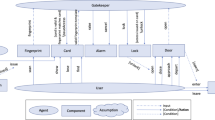Abstract
A systematic analysis of trace- and failure-based compositional semantic models for Basic LOTOS is presented. The analysis is motivated by the fact that the weakest known equivalences preserving sufficient information for several typical verification tasks are failure-based, and the weakness of an equivalence can be advantageous for verification. Both the equivalences and the preorders corresponding to the semantic models are covered. The analysis yields in a natural way two compositional semantic models, which are particularly suited for the verification of a general class of liveness properties, a task which cannot be performed with most established models.
Similar content being viewed by others
References
Bergstra, J. A., Klop, J. W. and Olderog, E.-R.: Failure Semantics with fair Abstraction. CWI Report CS-R8609, Centre for Mathematics and Computer Science, Amsterdam, The Netherlands 1986, 68 p.
Bergstra, J. A., Klop, J. W. and Olderog, E.-R.: Failures without Chaos: A New Process Semantics for Fair Abstraction. In:Formal Description of Programming Concepts III, North-Holland, 1987, pp. 77–103.
Bolognesi, T. and Brinksma, E.: Introduction to the ISO Specification Language LOTOS.Computer Networks and ISDN Systems 14 25–59 (1987). Also in:The Formal Description Technique LOTOS, North-Holland, 1989, pp. 23–73.
Bouajjani, A., Fernandez, J.-C. and Halbwachs, N.: Minimal Model generation. In:Computer-Aided Verification '90 (Proceedings of a Workshop), AMS-ACM DIMACS Series in Discrete Mathematics and Theoretical Computer Science, Vol. 3, American Mathematical Society, 1991, pp. 85–91.
Brinksma, E.: A Theory for the Derivation of Tests. In:Protocol Specification, Testing and Verification VIII, North-Holland, pp. 63–74. Also in:The Formal Description Technique LOTOS, North-Holland, 1989, pp. 235–247.
Brookes, S.D., Hoare, C. A. R. and Roscoe, A. W.: A Theory of Communicating Sequential Processes.Journal of the ACM, 31(3), 560–599 (1984).
Brookes, S. D. and Roscoe, A. W.: An Improved Failures Model for Communicating Sequential Processes. In:Proceedings of the NSF-SERC Seminar on Concurrency, Lecture Notes in Computer Science 197, Springer-Verlag, 1985, pp. 281–305.
Cheung, S. C. and Kramer, J.: Enhancing Compositional Reachability Analysis with Context Constraints.Proceedings of the First ACM SIGSOFT Symposium on the Foundations of Software Engineering, ACM Software Engineering Notes, 18(5) Dec. 115–125 (1993).
Darondeau, P. and Gamatie, B.: Infinitary Behaviours and Infinitary Observations.Fundamenta Informaticae XIII, 353–386 (1990).
De Nicola, R. and Hennessy, M.: Testing Equivalences for Processes.Theoretical Computer Science, 34, 83–113 (1984). Also: Internal Report CSR-123-82, Department of Computer Science, University of Edinburgh, 1982.
Eloranta, J.: Equivalence Concepts and Algorithms for Transition Systems and CCS-like Languages. Licentiate thesis, University of Helsinki, Department of Computer Science, Report C-1991-2, 1991.
Eloranta, J.: Minimal Transition Systems with Respect to Divergence Preserving Behavioural Equivalences. Doctoral thesis, University of Helsinki, Department of Computer Science, Report A-1994-1, Helsinki, Finland, 1994.
Glabbeek, R. J.: The Linear Time — Branching Time Spectrum. In:Proceedings of CONCUR '90, Lecture Notes in Computer Science 458, Springer-Verlag, 1990, pp. 278–297.
Graf, S. and Steffen, B.: Compositional Minimization of Finite State Processes. In:Computer-Aided Verification '90 (Proceedings of a Workshop), AMS-ACM DIMACS Series in Discrete Mathematics and Theoretical Computer Science, Vol. 3, American Mathematical Society, 1991, pp. 57–73.
Hoare, C. A. R.:Communicating Sequential Processes. Prentice-Hall, 1985.
ISO 8807 International Standard: Information processing systems-Open Systems Interconnection — LOTOS — A formal description technique based on the temporal ordering of observational behaviour. International Organization for Standardization, 1989.
Kaivola, R. and Valmari, A.: Using Truth-Preserving Reductions to Improve the Clarity of Kripke-Models. In:Proceedings of CONCUR '91, Lecture Notes in Computer Science 527, Springer-Verlag, 1991, pp. 361–375.
Kaivola, R. and Valmari, A.: The Weakest Compositional Semantic Equivalence Preserving Nexttime-less Linear Temporal Logic. In:Proceedings of CONCUR '92, Lecture Notes in Computer Science 630, Springer-Verlag, 1992, pp. 207–221.
Kanellakis, P. C. and Smolka, S. A.: CCS Expressions, Finite State Processes, and Three Problems of Equivalence.Information and Computation, 86(1) 43–68 (1990).
Leduc, G.: On the Role of Implementation Relations in the Design of Distributed Systems using LOTOS. PhD thesis, University of Liège, Belgium, 1990.
Leduc, G.: Failure-based Congruences, Unfair Divergences and New Testing Theory. To appear inProtocol Specification, Testing and Verification XIV, Chapman & Hall, 1994.
Milner, R.:Communication and Concurrency. Prentice-Hall, 1989.
Olderog, E.-R. and Hoare, C. A. R.: Specification-Oriented Semantics for Communicating Processes.Acta Informatica, 23, 9–66 (1986).
Pnueli, A.: Applications of Temporal Logic to the Specification and Verification of Reactive Systems: A Survey of Current Trends. In:Current Trends in Concurrency, Lecture Notes in Computer Science 224, Springer-Verlag 1986, pp. 510–584.
Sabnani, K. K., Lapone, A. M. and Uyar, M. Ü.: An Algorithmic Procedure for Checking Safety Properties of Protocols.IEEE Trans. Comm. 37(9), 940–948 (1989).
Valmari, A.: Alleviating State Explosion during Verification of Behavioural Equivalence. Department of Computer Science, University of Helsinki, Report A-1992-4, Helsinki, Finland, 1992.
Valmari, A.: Compositional State Space Generation. In:Advances in Petri Nets 1993, Lecture Notes in Computer Science 674, Springer-Verlag, 1993, pp. 427–457. (Earlier version inProceedings of the 11th International Conference on Application and Theory of Petri Nets, Paris, 1990, pp. 43–62.)
Valmari, A.: The Weakest Deadlock-Preserving Congruence. To appear inInformation Processing Letters.
Valmari, A. and Clegg, M.: Reduced Labelled Transition Systems Save Verification Effort. In:Proceedings of CONCUR '91, Lecture Notes in Computer Science 527, Springer-Verlag, 1991, pp. 526–540.
Valmari, A., Kemppainen, J., Clegg, M. and Levanto, M.: Putting Advanced Reachability Analysis Techniques Together: the “ARA” Tool. In:Proceedings of Formal Methods Europe '93, Lecture Notes in Computer Science 670, Springer-Verlag, 1993, pp. 597–616.
Valmari, A. and Tienari, M.: An Improved Failures Equivalence for Finite-State Systems with a Reduction Algorithm. In:Protocol Specification, Testing and Verification XI, North-Holland, 1991, pp. 3–18.
Author information
Authors and Affiliations
Rights and permissions
About this article
Cite this article
Valmari, A., Tienari, M. Compositional failure-based semantic models for Basic LOTOS. Formal Aspects of Computing 7, 440–468 (1995). https://doi.org/10.1007/BF01211218
Received:
Accepted:
Issue Date:
DOI: https://doi.org/10.1007/BF01211218




